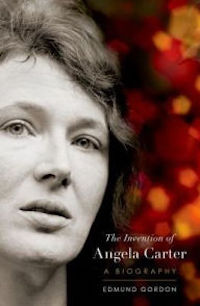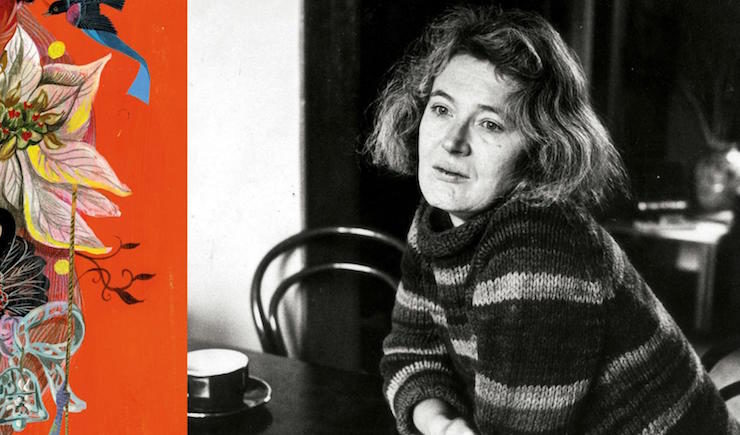At the International Conference for the Fantastic in the Arts (ICFA) this year, I had only one answer to the inevitable question of “What are you reading now/What was the last book you read that you were actually excited about?”
“This new biography of Angela Carter! You have to read it! She was such a horrible person and it’s amazing.”
I think the only other creative thing I expressed that much excitement about at ICFA was Voltron: Legendary Defender. Well, and maybe some of the booze. So I thought I should probably post about the book here.
Strictly speaking, The Invention of Angela Carter: a Biography is more a sifting through and weighing of the various truths and lies surrounding the life of Angela Carter—some from Carter herself, some from friends. Carter liked to create and recreate herself, both in her admitted fiction and her less admitted nonfiction, a process that often included telling strongly disputed stories about events in her past. Biographer Edmund Gordon set himself to the task of examining her life, and giving the most straightforward version he could.
To Tor.com readers, and specifically to readers of this post, Carter may be best known for her fairy tale retellings, particularly those collected in The Bloody Chamber (1979). Born in London in 1940, she spent much of her adult life traveling widely, touring the United States and much of Asia, and living in Japan, Australia and the United States for a few brief intervals—intervals often inspired by romantic relationships with various men or a need for money.
 She also wrote nine novels and five children’s books, along with several short stories, essays, radio plays and poems (collected in various editions), and translated the French fairy tales of Charles Perrault and Jeanne-Marie Le Prince de Beaumont—work that helped inspire The Bloody Chamber. In between this, she taught writing, and worked with younger writers—particularly those from working class backgrounds—to get their voices heard. She had a child at the comparatively late age of 43. An inveterate chain smoker, she died far too young of lung cancer in 1992 at the age of 51.
She also wrote nine novels and five children’s books, along with several short stories, essays, radio plays and poems (collected in various editions), and translated the French fairy tales of Charles Perrault and Jeanne-Marie Le Prince de Beaumont—work that helped inspire The Bloody Chamber. In between this, she taught writing, and worked with younger writers—particularly those from working class backgrounds—to get their voices heard. She had a child at the comparatively late age of 43. An inveterate chain smoker, she died far too young of lung cancer in 1992 at the age of 51.
To assemble the biography, Gordon interviewed most of Carter’s living relatives, friends and acquaintances. Some, including her first husband, declined; others spoke frankly—often, as in the case of one former lover admitting to previous illicit drug abuse and throwing around massive, expensive typewriters, perhaps a touch too frankly. He also dug through her journals and correspondence and other papers.
This is where I should, as a dutiful critic and Tor.com contributor, discuss, as Gordon does, Angela Carter’s role in the feminist movement of the 1960s through the 1980s and her (often uneasy) role in the British literary establishment, and just how Angela Carter felt (and Gordon feels) about a literary establishment that consistently described her as a woman writer, rather than a writer, and consistently left her out of Britain’s top literary prizes – a position which, Carter noted, she often shared with Doris Lessing.
But I’m not going to, because although this is all very interesting and Gordon does a nice job of tracing the British literary establishment and Carter’s rather unpleasant encounter with A.S. Byatt, and persuasively argues that Carter should be read as an artist first and a crusader second and although Carter’s up and down publication history is very comforting to read, as a writer, none of this is why you should read the book. No, you need to read this for the gossip.
This starts off with an outline of Angela Carter’s ancestors (who were sources for her fairy tale interpretations in The Bloody Chamber), continues on to discuss Carter’s controlling mother, and then gets into the good stuff. Gordon carefully sifts through the various stories about Angela Carter’s life to tell us who and when she slept with various people (including her best friend’s husband) and when exactly she picked up an STD (about when she was filing for divorce) and who she might have gotten said STD from (not from the best friend’s husband, but more than one candidate) and sex escapes in Japanese love hotels complete with tidbits about towels. Gordon’s habit of using first names for virtually everyone in the book just adds to the gossipy sense of intimacy.
Carter herself was not exactly known for telling the truth, even when she was only carefully shaping some of the stories of her past – stories that tended to change. When her versions contradict, as they frequently do, Gordon gives both, supplementing the stories, when he can, with verifiable data. Some of the better stories—like the one where she found another woman’s lipstick on her lover’s underwear, and then found herself laughing about it—were verified, more or less. But not always: that same lover, Sozo Araki, firmly denied Carter’s claim that she was his sole financial support at the time. Then again, Gordon, while not exactly taking sides in this dispute, notes that Sozo was speaking forty years after the event, and that Carter’s letters focus on her various attempts to earn money in Japan, putting this story into the “uncertain” category.
And Gordon does, alas, deny one of the more sensational rumors about Angela Carter—that while living on and off with the much younger man who would become her second husband, she also had an affair with poet Ted Hughes. In reality, it appears that they only met once, briefly, and no sex was involved. Fortunately Gordon finds several more gossipy tidbits to fill this gap.
None of the more interesting gossip seems to have changed Gordon’s admiration for Carter as a writer and a person. That admiration does lead to slightly awkward passages like this one, about the period right after she moved in with best friend Carole and Carole’s husband, John:
She [Angela Carter] was, however, a generous and solicitous housemate. Often, if John had been out, she would have found a passage in a book to interest him when he returned. After a while, left by themselves for most of each day, they began sleeping together.
My sense is that by “generous and solicitous,” most people would list “willing to do the dishes and laundry,” or “paying more than needed for rent,” not “finding a passage in a book.” Carter was not paying Carole and John rent, and she was working on a novel (Love) at the time, something that made her smoke nearly constantly and led to her frequently vanishing from social events. Sleeping with John, oddly, made her withdraw even more; eventually, he ended their sexual relationship. She blamed Carole.
 In another revealing moment—revealing more of Gordon than Carter—Gordon attempts to defend Carter’s frequent habit of living beyond her means, as in December 1973, when she earned 44 pounds and spent 106. Gordon follows this up by arguing that “although excepting books and cigarettes, the only luxuries she bought were a pair of boots (£11.99), sweets (£1.42) and Christmas presents for her family (£9.94). Fair enough—but exactly how much did she pay for those books and cigarettes for herself? Gordon doesn’t say, and it’s a bit difficult to agree with his conclusion that Carter was at least trying to be careful with money—especially since, just a few paragraphs after this, she was flying off to Japan again.
In another revealing moment—revealing more of Gordon than Carter—Gordon attempts to defend Carter’s frequent habit of living beyond her means, as in December 1973, when she earned 44 pounds and spent 106. Gordon follows this up by arguing that “although excepting books and cigarettes, the only luxuries she bought were a pair of boots (£11.99), sweets (£1.42) and Christmas presents for her family (£9.94). Fair enough—but exactly how much did she pay for those books and cigarettes for herself? Gordon doesn’t say, and it’s a bit difficult to agree with his conclusion that Carter was at least trying to be careful with money—especially since, just a few paragraphs after this, she was flying off to Japan again.
On the other hand, that admiration ensures that Gordon is a careful, considerate and sympathetic reader of Angela Carter’s stories—of real life and fiction – and makes this a marvelously readable, strangely sympathetic biography of a woman who clearly could be often hell to live with (even leaving aside the chain smoking), but also, endlessly fascinating. It also provides needed context for the striking stories of The Bloody Chamber, stories we will be taking a later look at. It’s an early contender for my Hugo ballot next year.
The Invention of Angela Carter is available in the US from Oxford University Press and in the UK from Chatto & Windus.
Top image: selection from the cover of the Chatto & Windus edition.
Mari Ness lives in central Florida.










